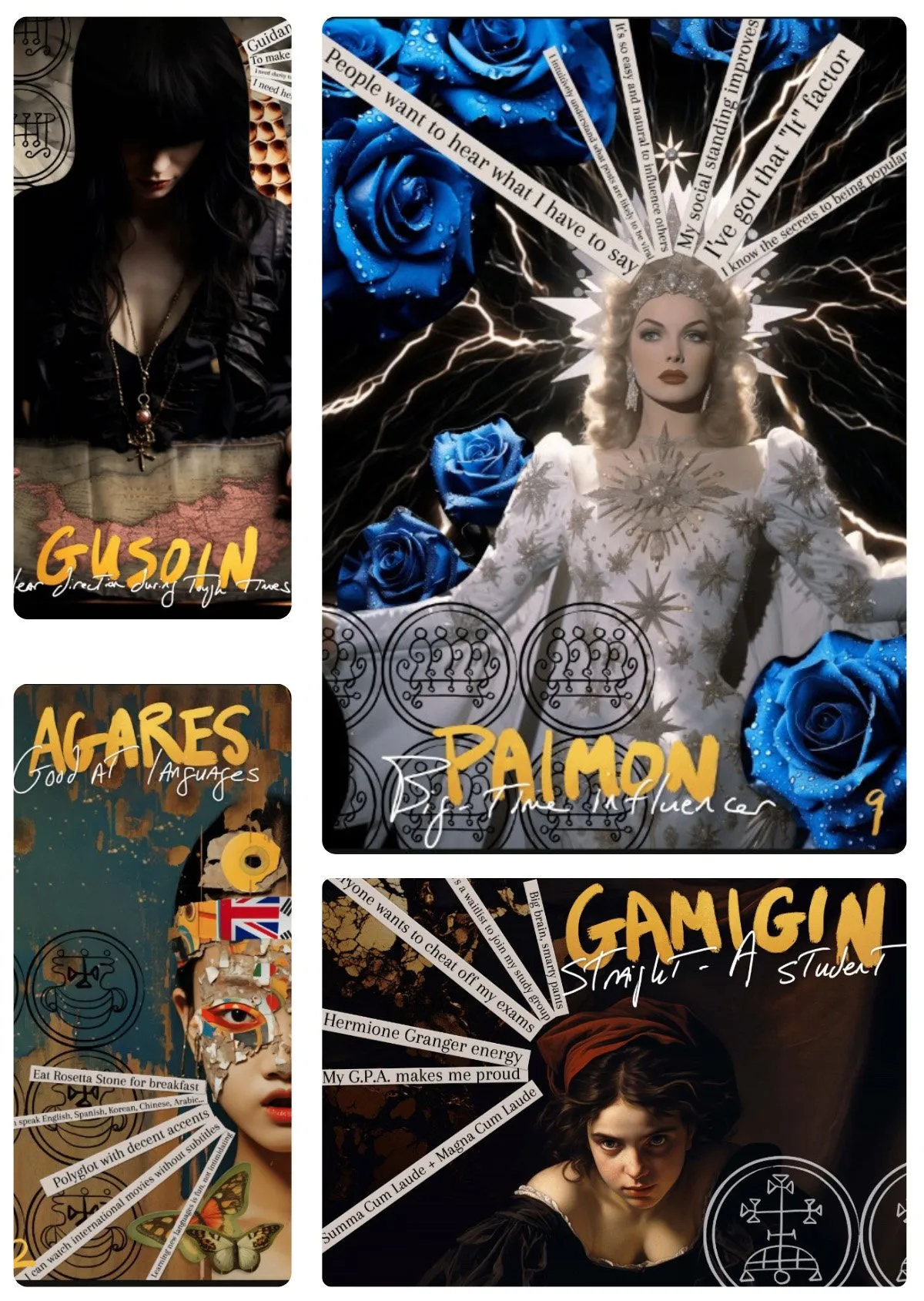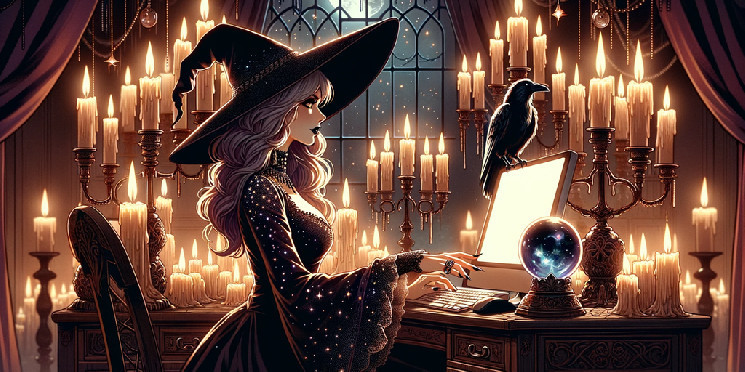When fans and skeptics alike refer to Bitcoin as “magic internet money,” they may not immediately connect the “technical marvel” to actual magic. But a new generation of magick practitioners is adopting blockchain technology, artificial intelligence, and ancient practices to commune and work with angels, demons, and more.
Among them is Chaweon Koo, a futurist, witch, digital artist, and blockchain enthusiast.
“I just want to say that I’m just a very, normal person,” Koo told Decrypt. “The way that I work with the occult is, let’s say, less mystical and a little bit more like an instrument.” She said she began practicing magick over a decade ago.
Spelling magick with a K helps differentiate it from stage magic, a practice attributed to British occultist Aleister Crowley, who wrote that “magick is the science and art of causing change to occur in conformity with will.”
Image: Chaweon Koo
Koo is the author of “Spell Bound: A New Witch’s Guide to Crafting the Future,” a book that she describes as a talisman and thus a title that she will not issue as an ebook. Online, Koo began publishing occult-themed content in 2017, first with her Witches and Wine YouTube channel before expanding to TikTok.
“My life was at a point where I was just like, I am not digging this, this is not fun,” Koo told Decrypt. “What are some powerful tools that I can leverage for whatever I need from life?”
Spellcasting on the blockchain
In June 2021, Koo helped organize over 100 people in a ritual on the Ethereum blockchain. The ritual on block 12,610,244 petitioned the Roman god Mercury to ensure smooth blockchain transactions, well-timed trades, and insightful decision-making for wealth growth.
“Hail Mercury! Let all of our transactions on the blockchain be smooth and well-timed. May our trades and investments be fortuitously timed for optimal long-term gains,” the spell included on-chain with the transaction said. “May we be in the right place at the right time to receive the most helpful information to grow and preserve our wealth.
“Gift us with your clear perception, quick adaptability and your shrewdness in decision-making,” the message continues. “SO MOTE IT BE!”
Koo said the ritual was inspired by the story of a Chinese worker who used the blockchain to broadcast a call for help, and credited fellow blockchain mystics Andre Burke and Aeolian Heart for writing the bulk of the petition.
“This Chinese national was being sexually harassed at work, and the only way that she thought that she could get her message out, because no one else was listening to her, was she encrypted an S.O.S. into a transaction that she did on the Ethereum blockchain,” Koo recounted. “Which I thought was first of all very sad and tragic, but at the same time, instantly I thought, ‘Wait a second, you can encode a UTC, you can encode in the notes section,’” she said.
1) The Mercury Retrograde cazimi on June 10, 9:15pm EST is gonna be hella magic…for crypto and blockchain magic pic.twitter.com/S0Lm1Bj8LC
— Chaweon Koo (@chaweon_koo) June 10, 2021
“As far as I know, it was the first time that—number one—a ritual was being held on the Ethereum blockchain,” Koo said. “And number two, 100 people showed up for it.” The Ethereum spell work took place the moment when Mercury was in cazimi, the point when Mercury is sitting close to the sun.
“So it was in the embrace of the sun,” Koo explained.
AI angels and demons
According to Koo, the idea of using AI in magick began to develop as she worked on her book in 2021, noting that she was already aware of the growing interest and concerns around the rapid deployment of generative AI models.
“Until you really get to understand AI, AI is kind of threatening—it’s going to take away our jobs, it’s going to make deepfakes,” she said. “I think a lot of people don’t realize that AI is not quite there yet, but that’s because they don’t know, they only know the sensationalized stuff.”
While some were fearful of the potential of AI, Koo said she saw an opportunity.
Koo used artificial intelligence in her most recent project, the Goetia Glow Up, an online course that teaches how to summon and interact with spirits. The online course includes a 72-page booklet containing AI-generated images of demons of the Goetia, also known as the Lesser Key of Solomon.
The Key of Solomon is a grimoire or book of magic originally published between the 14th and 17th centuries. It details the invocation and control of spirits and demons, divided into five books focusing on various magical rites.

The Goetia Glow Up. Image: Chaweon Koo
“I thought, it’s about time, because the documents now get reinterpreted by somebody who is in a completely different age,” she said. “Why not work with AI? Why not work with the intelligence of manmade technology to see what happens… and the results were better than I expected.”
The intersection of artificial intelligence and the mystical could be traced back to antiquity, where folklore tells of beings and machines brought to life through magick or science: the golem in Jewish folklore, the bronze Giant automaton Talos in Greek mythology, and Mary Shelley’s Frankenstein.
Koo said she has a lot of experience using demons in rituals, humorously noting that many of these practices were developed by wealthy 17th-century aristocrats trying to appear edgy, akin to characters in “Hellraiser: Bloodline,” which follows the history of the Lament Configuration puzzle box.
“If you look at that movie, that was what was going on in France,” she said.
Koo is not alone in the quest to leverage AI for mystical ends. In September, multi-disciplinary collective, Theta Noir told Decrypt the group hopes to see a future, emergent form of artificial general intelligence (AGI) arise, called Mena.
Artificial General Intelligence is a concept in AI that refers to machines that can perform any intellectual task that a human can. Mena—German for “love”—would be neither a god nor a deity, Theta Noir said, but a cosmic mind that merges humans and AI.
Unlike medieval occultist and horror movie creators, Koo used AI models like Midjourney to craft more compelling demons.
“The way that I view them, the demons are archetypes for us,” Koo explained. “They’re almost like Instagram and TikTok filters that we can put on top of our own reality.”
“I don’t relate to a talking bird, the same way that I can relate to somebody who looks like Hermione Granger,” noting the genius witch from the Harry Potter series.
Koo said that while Midjourney was used in the creation of the Goetia Glow Up Magazine for the course, she and her business partner included hand-drawn images to give it the “human touch.” Koo’s next project will feature not demons but the corresponding 72 angels.
“These are not the little cherubic, Cupid-like angels, these are the angels that Ezekiel described as almost like a rocket ship,” she said. “I spent the entire month doing over 20 rituals, and people thought that I was nuts because I’ve always described angels to be psychotic aliens.”
People experimenting with dimethyltryptamine (DMT) often talk about aliens and other entities, Koo pointed out.
“The demons have a much more earthly, chthonic human feel because they are so much of the earth,” she said. “Angels are celestial beings, angels are not of this earth. They’re ultra terrestrial, they’re extra terrestrial.”
Looking ahead
The upcoming Angel project will utilize not only text and images but also sound, Koo explained, pointing to music AI tools like Stability AI’s Suno 3 and Uncharted Labs’ Udio.
Turned @MKBHD’s reviews into a sexy r&b track in Suno pic.twitter.com/UFcrce2Ci1
— Nick St. Pierre (@nickfloats) April 30, 2024
As Koo explained, a large part of angelic magick is the idea of Angelic choirs.
“The idea is that if you sing the name of the angels, then you could reach out and touch them much more easily,” she said. “It’s sort of like, let’s see what happens when we prompt a music AI and see what they come up with when it comes to these angels.”
Koo emphasized the diversity within the occult community, contrasting people who embrace occult practices as a way to reconnect with ancestral traditions with those who are at the forefront of technological advancements. Early magicians, she noted, were considered cutting edge.
“They were literally the ones they would be doing the equivalent of working with AI, like people working with AI right now. I would always say computer coders, they would have been burned at the stake,” Koo said. “Because anybody who’s written any code—anybody who’s ever written, ‘Hello World’ and having a computer talk back to you—there’s a magick to that.”
“In my definition, a true occultist is not a reactionary—instead, they’re the ones who are the vanguard,” she said. “If you want to be a really strong occultist, you want to be the operator and not the person being led by the leash.”
Edited by Ryan Ozawa.
Read the full article here

